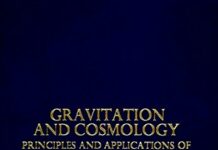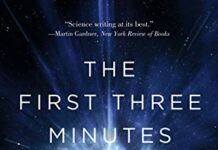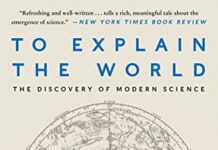
Ebook Info
- Published: 1990
- Number of pages: 222 pages
- Format: PDF
- File Size: 27.60 MB
- Authors: Steven Weinberg
Description
This commentary on the discovery of the atom’s constituents provides an historical account of key events in the physics of the twentieth century that led to the discoveries of the electron, proton and neutron. Steven Weinberg introduces the fundamentals of classical physics that played crucial roles in these discoveries. Connections are shown throughout the book between the historic discoveries of subatomic particles and contemporary research at the frontiers of physics, including the most current discoveries of new elementary particles. Steven Weinberg was Higgins Professor of Physics at Harvard before moving to The University of Texas at Austin, where he founded its Theory Group. At Texas he holds the Josey Regental Chair of Science and is a member of the Physics and Astronomy Departments. His research has spanned a broad range of topics in quantum field theory, elementary particle physics, and cosmology, and has been honored with numerous awards, including the Nobel Prize in Physics, the National Medal of Science, the Heinemann Prize in Mathematical Physics, the Cresson Medal of the Franklin Institute, the Madison Medal of Princeton University, and the Oppenheimer Prize. In addition to the well-known treatise, Gravitation and Cosmololgy, he has written several books for general readers, including the prize-winning The First Three Minutes (now translated into 22 foreign languages), and most recently Dreams of a Final Theory (Pantheon Books, 1993). He has also written a textbook The Quantum Theory of Fields, Vol.I, Vol. II, and Vol. III (Cambridge).
User’s Reviews
Reviews from Amazon users which were colected at the time this book was published on the website:
⭐In this book we see the older Weinberg who stillthought in terms of mathematics and experimentand not in terms of defending his theoriesagainst an uncertain future.This book I can give to the younger generation in conscienceand say : be wise and read this and learn.
⭐Steven Weinberg (born 1933) is a Nobel Prize-winner in Physics for his contributions to the unification of the weak force and electromagnetic interaction between elementary particles. He has also written books such as
⭐,
⭐,
⭐, etc.He wrote in the Preface to this 1983 book, “This book grew out of a course that I gave at Harvard in the spring of 1980… The idea of the course, in brief, was to engage students who were not assumed to have any prior training in mathematics or physics in learning about the great achievements of twentieth-century physics… The book covers the discovery of the fundamental particles that make up all ordinary atoms: the electron, the proton, and the neutron. The general outline is historical, but it is history with one significant difference… This book is written for readers who may not be familiar with classical physics, but who are willing to pick up enough o fit as they go along to be able to understand the rich tangle of ideas and experiments that make up the history of twentieth century physics… flashback sections and the background material interspersed in other sections represent my secret motivation in writing this book.” (Pg. x-xi)He continues, “My hope… is that this book may contribute to a radical revision in the way that science if brought to nonscientists… This book is intended to be comprehensible to readers who have no prior background in science, and no familiarity with mathematics beyond arithmetic… Although this book is written for the nonscientist, it has one aspect that perhaps also my fellow physicists may find interesting. The great scientific achievements described here form a large part of the soil from which our own more recent harvest of discoveries have sprung. Yet I, for one, had only toe foggiest idea of the early history of twentieth-century physics when I started to teach the courses at Harvard and Texas, and I suspect that the same is true of many of my colleagues in physics. I hope that scientists may find some of the history… in the book enlightening.” (Pg. xii)He explains, “All ordinary matter is composed of atoms, which in turn consist of protons, neutrons, and electrons… The electron is just one member of a family of particles called leptons, of which some half dozen are now known. The proton and the neutron are members of much larger family of particles called hadrons, of which hundreds are known… Electrons are believed to be absolutely stable, and protons and neutrons (when bound in an atomic nucleus) live at least [10 to the 30th power[ years. With a few exceptions, all other particles have very short lifetimes, and are therefore very rare in the present universe… The proton, the neutron, and the other hadrons are … composites themselves, made up of … quarks. As far as is known, the electron and the members of the lepton family are truly elementary.” (Pg. 4)He notes, “Atoms are electrically neutral, but the electrons discovered by Thomson carry a negative electric charge. If atoms contain electrons, then they must also contain some other material that carries a positive charge to cancel the electrons’ negative charge. The great task after the discovery of the electron was to identify this positive material and to describe how it and the electrons are arranged within the atom.” (Pg. 104)He recounts, “during the exciting period in the 1920s when quantum mechanics was being developed, a colleague asked ‘How is physics these days, [Ernest] Rutherford?’ and Rutherford replied, ‘…the theorists are on their hind legs and it is up to us to get them down again.’ As a theorist I naturally tend to deplore this sort of antitheoretical feeling. Bu tin fact theorists and experimentalists generally get along pretty well with each other, and could hardly get along at all without each other. Rutherford’s attitude may have been partly due to the face that his greatest work was done during a time when so little was known about the nucleus that elaborate mathematical theorizing would have been out of place, and whatever theory was called for, Rutherford was quite capable of supplying himself.” (Pg. 108-109)He concludes, “I hope that the reader will not conclude from the account or particle physics I have given here that this branch of physics has degenerated into a kind of butterfly collecting, with the peculiarity that the butterflies we collect do not live long enough to be found in nature and have to be created in the laboratory of the collector. I think that this view is quite wrong. Once the age-old question of the nature of ordinary matter was settled… the question shifted. The real task we address … is not to develop a list of particles and their properties. It is to understand the underlying principles that dictate why nature… is the way it is. All our experience shows that the study of elementary particles is at present the best and perhaps the only way of getting at the fundamental laws of nature.” (Pg. 168)Weinberg presents an engaging history, rather than just a dry recounting of facts. This book will be of great interest to those studying the history of particle physics.
⭐This book is a deviation from the author’s usual books about complex cosmological issues. The Discovery of Subatomic Particles is accessible to anyone, an easy read revealing much about scientific method. It’s more a history of how scientists and physicists with rather rudimentary tools devised innovative ways to probe and measure atomic particles with surprisingly accurate results. This book will be appreciated by the mechanically inclined. For the mathematically inclined, you will see in the appendices calculations developed in such a way that requires only a basic background in algebra to understand.The author guides the reader through the history of processes that refined our understanding of the subatomic world. The subject matter is covered in a logical timeline progression and consistent format. Quantum theory is outside the scope of this book, but Niels Bohr is included in the history for using some of the discoveries to formulate his view of electron dynamics. The reader will gain a higher appreciation of how much can be measured and discovered using the basic tools and instruments available at a given level of scientific development.Extensive appendices amount to a concise development of fundamental physics, itself creating much value owning this book. My favorite appendix has the author describing how much of Rutherford’s formula for the scattering of alpha particles can be derived through simple dimensional analysis, continuing the historic application of basic tools to analyze, measure, and discover subatomic particles. The appendices give the technical details supporting much of the scientific development described so well in the main text. Steven Weinberg’s book, The Discovery of Subatomic Particles, is an easy read that can be appreciated by anyone.
⭐This copy is to be used for an academic course. The recipient is delighted. What you always wanted to know!
⭐Good to read book with an interesting topic
Keywords
Free Download The Discovery of Subatomic Particles in PDF format
The Discovery of Subatomic Particles PDF Free Download
Download The Discovery of Subatomic Particles 1990 PDF Free
The Discovery of Subatomic Particles 1990 PDF Free Download
Download The Discovery of Subatomic Particles PDF
Free Download Ebook The Discovery of Subatomic Particles



